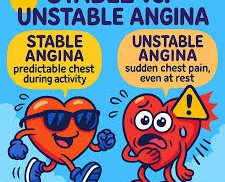Living with Chronic Stable Angina – Understanding, Managing, and Improving Heart Health


What Is Chronic Stable Angina and Why Does It Occur?
Have you ever experienced a tight, pressing pain in your chest during exercise that disappears when you rest? That may be chronic stable angina. It develops when the arteries that supply blood to the heart become narrowed, usually from plaque buildup. Because of this, the heart receives less oxygen, especially during activity, when it needs more energy. This condition tends to follow a predictable pattern over time.
Main points to understand:
- The heart muscle depends on a steady flow of oxygen-rich blood.
- Narrowed arteries caused by fatty deposits reduce this flow.
- Physical effort or strong emotions can trigger chest pain.
- Discomfort may also spread to the arms, shoulders, or neck.
Understanding what causes angina is the first step toward controlling it and protecting your heart from future damage.Chronic stable angina is a signal that your heart needs consistent care and attention.
Recognizing the Warning Signs
Many people ignore chest pain until it becomes severe. But chronic stable angina often shows a clear and repeatable pattern, making it easier to recognize early. By understanding how and when symptoms appear, individuals can take timely action before the condition worsens.
Typical symptoms include:
- A feeling of tightness, heaviness, or pressure in the chest.
- Shortness of breath after even mild activity.
- Pain or discomfort that goes away with rest or medication.
- Fatigue, sweating, or nausea when under physical strain.
Identifying these signs early helps prevent serious heart complications and allows for better management. Recognizing and responding to symptoms quickly supports long-term heart health.
Everyday Triggers That Cause Angina Pain
Daily routines often have a stronger effect on the heart than people realize. Even small habits, like eating too fast or getting angry easily, can increase strain on the heart and trigger angina pain. By learning what activities or emotions set off discomfort, patients can plan their day in a safer way.
Common triggers include:
- Emotional stress or anger that increases heart rate.
- Intense physical exertion without rest periods.
- Heavy or greasy meals that strain digestion.
- Cold weather that tightens blood vessels.
- Smoking or exposure to tobacco smoke.
Making simple adjustments to avoid these triggers can reduce the frequency of chest pain and improve comfort. Knowing what brings on pain allows you to take control and live more freely.
The Role of Lifestyle and Diet in Managing Angina
A balanced lifestyle can greatly reduce the severity of chronic stable angina. A heart-friendly diet, moderate exercise, and stress control work together to improve circulation and energy. These changes not only ease angina symptoms but also protect against other heart problems in the future.
Helpful lifestyle habits include:
- Eating a diet rich in fruits, vegetables, and lean proteins.
- Reducing salt, saturated fats, and added sugars.
- Quitting smoking and limiting alcohol intake.
- Practicing regular, gentle exercise like walking or cycling.
- Learning relaxation techniques such as deep breathing.
Over time, these habits lower blood pressure, improve heart strength, and increase energy levels. Healthy daily choices build the foundation for a stronger heart and longer life.
How Stress and Emotions Affect the Heart
Stress may seem like an emotional problem, but it strongly affects heart function. When you are anxious or upset, your body releases hormones that increase your heart rate and tighten blood vessels, making it harder for the heart to get oxygen. Managing stress is therefore a vital part of angina treatment.
Ways to reduce emotional strain:
- Practice deep breathing or simple meditation each day.
- Maintain regular sleep patterns and avoid late nights.
- Spend time in nature or with supportive people.
- Seek counseling or therapy when stress becomes overwhelming.
A calm and balanced mind helps maintain steady heart function and lowers the chance of angina attacks. Peace of mind is one of the best medicines for your heart.
Coreg and Its Role in Heart Health
Sometimes lifestyle changes alone are not enough. In such cases, medications like Coreg (Carvedilol) are often recommended by doctors to help the heart cope with reduced blood flow. This medication supports the heart by decreasing its workload and improving how efficiently it pumps blood.
Coreg may help by:
- Relaxing blood vessels so that blood can flow more easily.
- Lowering heart rate and blood pressure gently.
- Reducing how hard the heart must work to circulate blood.
- Lessening the frequency of chest pain during effort.
Coreg is usually part of a broader treatment plan that includes diet, activity, and regular monitoring by a healthcare provider. Coreg supports the heart’s strength and stability, helping patients stay active and safe.
How Coreg (Carvedilol) Works in Managing Chronic Stable Angina
Coreg works by balancing the heart’s rhythm and easing the pressure on its muscles. It helps the heart beat more steadily and improves blood flow, which reduces the risk of oxygen shortage during activity. Over time, this leads to fewer angina episodes and a more stable condition.
Key benefits include:
- Helping the heart handle stress and daily physical demands.
- Improving blood circulation to heart tissues.
- Supporting long-term heart muscle health.
- Lowering the risk of future complications.
Patients who take Coreg as prescribed often notice greater endurance and less discomfort in daily life. Coreg offers a reliable way to manage angina symptoms and live more comfortably.
Living Comfortably with Chronic Stable Angina
Life with chronic stable angina can still be full and active. With awareness, proper care, and commitment, people can manage their symptoms effectively. Following a personalized plan made with your doctor ensures the safest path forward.
Steps to better living:
- Follow a nutritious and heart-conscious diet daily.
- Stay physically active within safe limits.
- Take prescribed medications consistently.
- Keep regular check-ups with your healthcare provider.
- Maintain a positive attitude and emotional balance.
Combining all these steps provides the best protection and helps you live well despite angina. With medical guidance and self-care, chronic stable angina can be controlled, leading to a healthier and more confident life.
Drug Description Sources: U.S. National Library of Medicine, Drugs.com, WebMD, Mayo Clinic, RxList
Reviewed and Referenced By:
- Dr. Alan Carter, PharmD – Clinical pharmacist specializing in cardiovascular and metabolic conditions. Frequently cited on Drugs.com for therapeutic reviews related to blood pressure and heart medications.
- Dr. Sarah Mitchell, MD – Cardiologist affiliated with the Mayo Clinic, contributing to research on chronic heart disease and treatment response.
- Dr. James Porter, PharmD – Research contributor for RxList and WebMD, focusing on drug safety and patient care outcomes.
- Dr. Lisa Grant, MD – Internal medicine specialist and reviewer for the U.S. National Library of Medicine, focusing on long-term heart management and clinical guidance.
Article Post: Editorial Team of RXShop.md
(Updated at Oct 18 / 2025)

